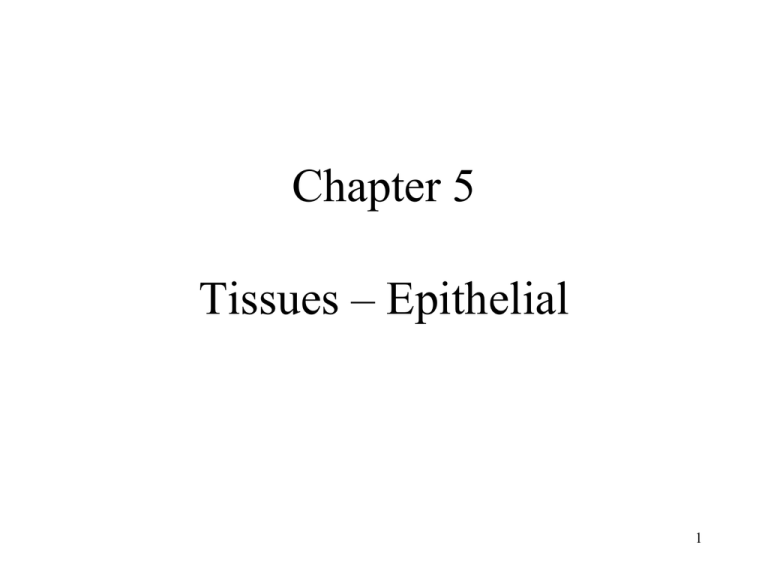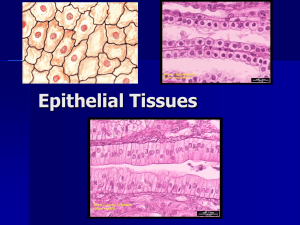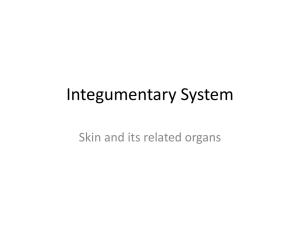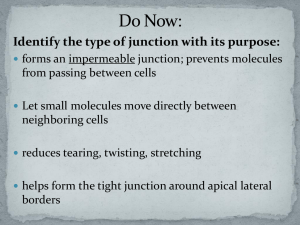
Chapter 5
Tissues – Epithelial
1
Introduction
• Similar cells with a common function are called
tissues.
• The study of tissues is called histology.
• There are four (4) primary or major tissue types:
1.
2.
3.
4.
Epithelial Tissue (covering/lining; ET)
Connective Tissue (support; CT)
Muscle Tissue (movement; MT)
Nervous Tissue (control; NT)
2
Nervous tissue: Internal communication
• Brain, spinal cord, and nerves
Muscle tissue: Contracts to cause movement
• Muscles attached to bones (skeletal)
• Muscles of heart (cardiac)
• Muscles of walls of hollow organs (smooth)
Epithelial tissue: Forms boundaries between different
environments, protects, secretes, absorbs, filters
• Skin surface (epidermis)
• Lining of GI tract organs and other hollow organs
Connective tissue: Supports, protects, binds
other tissues together
• Bones
• Tendons
• Fat and other soft padding tissue
Figure 4.1
Epithelial
Tissue
Epithelial Tissue (Epithelium)
Two main types (by location):
1. Covering and lining epithelia
•
On external and internal surfaces
o
o
body (i.e. epidermis) and
ventral cavity organs (i.e. visceral serous membranes)
2. Glandular epithelia
•
Secretory tissue in glands
o internal spaces (i.e. lumen of the intestine),
o line body cavities (i.e. parietal membranes),
o line ducts of exocrine glands (i.e. sweat glands).
Functions of Epithelial Tissue
•
•
•
•
Protection
Absorption
Filtration
Secretion
5
Characteristics of Epithelial
Tissue
1.
Cells exibit polarity—apical (upper, free) and basal
(lower, attached) surfaces
– Apical surfaces may bear microvilli (e.g., brush border
of intestinal lining) or cilia (e.g., lining of trachea).
– Apical surfaces always have a free space, which opens
to the outside or to an internal space (lumen)
– Noncellular basal lamina of glycoprotein and collagen
lies adjacent to basal surface
Characteristics of Epithelial
Tissue
2.
3.
4.
5.
6.
7.
Cellularity - cells are in close contact with each other
with little or no intercellular space between them.
Supported by a connective tissue - reticular lamina
(under the basal lamina) at the basal surface, both the
epithelial tissue and the connective tissue contribute to
the basement membrane
Avascular (no blood supply).
Innervated (supplied with nerves)
Rely on diffusion and underlying connective tissue for
nutrients and O2
High rate of regeneration
8
Cellularity - Intercellular
Junctions
Tight junctions
• Close space between cells
• Located among cells that form linings
• lining cells in small intestine
• kidney tubules
• blood-brain barrier
Copyright © The McGraw-Hill Companies, Inc. Permission required for reproduction or display.
Desmosomes
• Form “spot welds” between cells
• Found in tissues that undergo
repeated episodes of tension and stretching
• skin, heart, uterus
Cell membrane
Tight junction
Cell membrane
Desmosome
Cell membrane
Gap junctions
• Tubular channels between cells
• Located in cardiac muscle cells
• cardiac muscle cells
• digestive smooth muscle cells
Gap junction
9
Basement Membrane:
The Basal Lamina
• Noncellular supporting sheet between the epithelium
and the connective tissue deep to it
• Consists of proteins secreted by the epithelial cells
• Functions:
– Acts as a selective filter, determining which
molecules from capillaries enter the epithelium
– Acts as scaffolding along which regenerating
epithelial cells can migrate
• Basal lamina and reticular layers of the underlying
connective tissue form the basement membrane
Classifications of Epithelia
• First name of tissue indicates number of layers
– Simple – one layer of cells
– Stratified – more than one layer of cells
- Pseudostratified- tissue appears to be stratified, but all
cells contact basement membrane so it is in fact simple
Classifications of Epithelia
• Last name of tissue describes shape of cells
– Squamous – cells wider than
tall (plate or “scale” like)
– Cuboidal – cells are as wide as
tall, as in cubes
- Columnar – cells are taller than
they are wide, like columns
Epithelial Tissue
• Simple squamous:
• Simple cuboidal:
• Single layer of flat cells
• Substances pass easily through
• Line air sacs
• Line blood vessels
• Line lymphatic vessels
• Single layer of cube-shaped cells
• Line kidney tubules
• Cover ovaries
• Line ducts of some glands
Copyright © The McGraw-Hill Companies, Inc. Permission required for reproduction or display.
Copyright © The McGraw-Hill Companies, Inc. Permission required for reproduction or display.
Free surface
of tissue
Lumen
Nucleus
Simple
squamous
epithelium
Basement
membrane
Basement
Free surface
of tissue
Nucleus
Simple
cuboidal
epithelium
Connective
tissue
Connective
tissue
(a)
(b)
b,d: © Ed Reschke
(a)
(b)
b: © The McGraw-Hill Companies, Inc./Al Telser, photographer
13
Simple Squamous Epithelium
Figure 4.3a
Simple Cuboidal Epithelium
Figure 4.3b
Epithelial Tissue
• Simple columnar:
• Pseudostratified columnar:
• Single layer of elongated cells
• Nuclei usually near the basement
• Membrane at same level
• Sometimes possess cilia
• Sometimes possess microvilli
• Often have goblet cells
• Line uterus, stomach, intestines
• Single layer of elongated cells
• Nuclei at two or more levels
• Appear striated
• Often have cilia
• Often have goblet cells
• Line respiratory passageways
Copyright © The McGraw-Hill Companies, Inc. Permission required for reproduction or display.
Cilia
(free surface
of tissue)
Copyright © The McGraw-Hill Companies, Inc. Permission required for reproduction or display.
Cytoplasm
Mucus
Goblet cell
Nucleus
Nucleus
Cytoplasm
Basement
membrane
Microvilli
(free surface
of tissue)
Connective
tissue
Goblet cell
(a)
(b)
Basement
membrane
b: © The McGraw-Hill Companies, Inc./Dennis Strete, photographer
Connective
tissue
(a)
(b)
16
b: © The McGraw-Hill Companies, Inc./Al Telser, photographer.
Simple Columnar Epithelium
Figure 4.3c
Pseudostratified Ciliated
Columnar Epithelium
Figure 4.3d
Stratified Epithelial Tissue
•
•
•
•
Contain two or more layers of cells
Regenerate from below
Major role is protection
Are named according to the shape of cells at
apical layer
Stratified Squamous Epithelium
• Specific types
– Keratinized – contain the protective protein keratin
• Surface cells are dead and full of keratin
– Non-keratinized – forms moist lining of body openings
• Function
– Protects underlying tissues in areas subject to abrasion
• Location
– Keratinized – forms epidermis
– Non-keratinized – forms lining of esophagus, mouth, and
vagina
Epithelial Tissue
• Stratified squamous:
• Stratified cuboidal:
• Many cell layers
• Top cells are flat
• Can accumulate keratin
• Outer layer of skin
• Line oral cavity, vagina, and
anal canal
• 2-3 layers
• Cube-shaped cells
• Line ducts of mammary glands,
sweat glands, salivary glands, and
the pancreas
Copyright © The McGraw-Hill Companies, Inc. Permission required for reproduction or display.
Copyright © The McGraw-Hill Companies, Inc. Permission required for reproduction or display.
Free surface
of tissue
Stratified
cuboidal
epithelium
Nucleus
Squamous
cells
Lumen
Free surface
of tissue
Basement
membrane
Connective
tissue
(a)
(b)
Layer of
dividing
cells
Basement
membrane
b: © The McGraw-Hill Companies, Inc./Al Telser, photographer.
Connective
tissue
(a)
(b)
b: © The McGraw-Hill Companies, Inc./Al Telser, photographer
21
Stratified Squamous Epithelium
Figure 4.3e
Stratified Cuboidal Epithelium
• Description
– generally two layers
of cube-shaped cells
• Function
– protection
• Location
– Forms largest ducts
of sweat glands
– Forms ducts of
mammary glands
and salivary glands
Epithelial Tissue
• Transitional:
• Stratified columnar:
• Many cell layers
• Cube-shaped and elongated
cells
• Line urinary bladder,
ureters, and part of urethra
• Top layer of elongated cells
• Cube-shaped cells in deeper
layers
• Line part of male urethra and
part of pharynx
Copyright © The McGraw-Hill Companies, Inc. Permission required for reproduction or display.
Free surface
of tissue
Unstretched
transitional
epithelium
Copyright © The McGraw-Hill Companies, Inc. Permission required for reproduction or display.
Lumen
Basement
membrane
Free surface
of tissue
Stratified
columnar
epithelium
(a)
Underlying
connective tissue
(b)
Basement
membrane
Free surface
of tissue
Stretched
transitional
epithelium
Connective
tissue
(a)
(b)
Basement
membrane
Underlying
connective tissue
b: © The McGraw-Hill Companies, Inc./Al Telser, photographer
(c)
(d)
b,d: © Ed Reschke
24
Stratified Columnar Epithelium
• Description
– several layers; basal
cells usually cuboidal;
superficial cells
elongated
• Function
– protection and
secretion
• Location
– Rare tissue type
– Found in male urethra
and vas deferens,
largest ducts of salivary
glands, nasopharynx
Transitional Epithelium
Figure 4.3h
Glandular Epithelium
• A gland is one or more cells that makes and secretes an
aqueous fluid
•Composed of cells that are specialized to produce and
secrete substances
• There are two (2) types:
• Endocrine glands no contact with exterior
of body; ductless; produce hormones
(pituitary, thyroid, adrenals, pancreas)
• Exocrine glands
o Exocrine glands classified either by structure or
by the method of secretion
o Classified by structure
27
Endocrine Glands
• Glands that do not have ducts or tubules
and whose secretions are distributed
throughout the body
• Produce and secrete hormones into the
bloodstream or the lymphatic system
• Part of a complex, biochemical network
known as the endocrine system
28
Exocrine Glandular Epithelium
• Unicellular
exocrine gland:
• Composed of one cell
• Goblet cell
• Multicellular exocrine gland:
• Composed of many cells
• Sweat glands, salivary glands, etc.
• Simple and compound
29
Unicellular Exocrine Glands
(The Goblet Cell)
• Goblet cells produce
mucin
• Mucin + water mucus
• Protects and lubricates
many internal body
surfaces
Multicellular Exocrine Glands
• Classified by structure (branching & shape) of
duct
• Classified on the basis of types of ducts or mode
of secretion
• Types of ducts
– Simple: ducts with few branches
– Compound: ducts with many branches
• Mode of Secretion
– Merocrine secretion – secretory vesicles released
via exocytosis (saliviary glands)
– Apocrine secretion – apical portion of the cell is
lost, cytoplasm + secretory product (mammary
glands)
– Holocrine secretion – entire cell is destroyed
during secretion (sebaceous gland)
May also be classified by types of
secretions from exocrine glands
• Serous
– mostly water but also contains some enzymes
– Ex. parotid glands, pancreas
• Mucous
– mucus secretions
– Ex. sublingual glands, goblet cells
• Mixes
– serous & mucus combined
– Ex. submandibular gland
Types of Glandular Secretions
• Merocrine Glands • Apocrine Glands
• Fluid product
• Salivary glands
• Pancreas gland
• Sweat glands
• Holocrine Glands
• Cellular product
• Portions of cells
• Mammary glands
• Ceruminous glands
• Secretory products
• Whole cells
• Sebaceous glands
Copyright © The McGraw-Hill Companies, Inc. Permission required for reproduction or display.
Intact
cell
Secretion
Pinched off
portion of cell
(secretion)
Disintegrating cell
and its contents
(secretion)
New cell
forming by
mitosis and
cytokinesis
(a) Merocrine gland
(b) Apocrine gland
(c) Holocrine gland
33
Structural Types of
Exocrine Glands
Copyright © The McGraw-Hill Companies, Inc. Permission required for reproduction or display.
Tissue surface
Duct
Secretory portion
Simple tubular Simple branched
tubular
Compound tubular
Simple coiled
tubular
Compound alveolar
Simple branched
alveolar
34
Exocrine Vs. Endocrine Glands
• Endocrine Gland Characteristics:
– Ductless glands
– Secrete substances directly into bloodstream
– Produce molecules called hormones
Which
is
Which?










